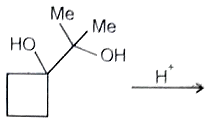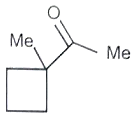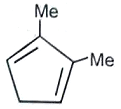In the reaction sequence, X and Y, respectively are
1.
2.
3.
4.
Two isomer compounds, I and II, are heated with HBr.
The products obtained are respectively:
| 1. |  |
| 2. |  |
| 3. |  |
| 4. |  |
The major product of the following reaction is

1. 
2. 
3. 
4. 
Phenol on treatment with dilute HNO3 gives two products P and Q. P is steam volatile but Q is not. P and Q are, respectively:
| 1. |  |
| 2. |  |
| 3. |  |
| 4. |  |
The compound which reacts with excess bromine to produce 2, 4, 6-tribomophenol, is:
1. 1, 3-cyclohexadiene
2. 1, 3-cyclohexanedione
3. Salicylic acid
4. Cyclohexanone

To unlock all the explanations of 20 chapters you need to be enrolled in MasterClass Course.

To unlock all the explanations of 20 chapters you need to be enrolled in MasterClass Course.
Major products obtained from t-butyl methyl ether and HI reaction are:
1.
2.
3.
4.

To unlock all the explanations of 20 chapters you need to be enrolled in MasterClass Course.

To unlock all the explanations of 20 chapters you need to be enrolled in MasterClass Course.
X, Y, and Z in the following reaction sequence are:
| 1. |  |
| 2. |  |
| 3. |  |
| 4. |  |

To unlock all the explanations of 20 chapters you need to be enrolled in MasterClass Course.

To unlock all the explanations of 20 chapters you need to be enrolled in MasterClass Course.
In the following reaction sequence
X and Y are:
| 1. |  |
| 2. |  |
| 3. |  |
| 4. |  |

To unlock all the explanations of 20 chapters you need to be enrolled in MasterClass Course.

To unlock all the explanations of 20 chapters you need to be enrolled in MasterClass Course.
The order of reactivity of the following Compounds in electrophilic monochlorination at the most favourable position is

1. I < II < IV < III
2. III < IV < I < II
3. IV < III < II < I
4. III < II < IV < I

To unlock all the explanations of 20 chapters you need to be enrolled in MasterClass Course.

To unlock all the explanations of 20 chapters you need to be enrolled in MasterClass Course.
Four processes are indicated below.
The processes that do not produce 1-methyl cyclohexanol are
1. II, IV
2. I, II
3. III, IV
4. I, III

To unlock all the explanations of 20 chapters you need to be enrolled in MasterClass Course.

To unlock all the explanations of 20 chapters you need to be enrolled in MasterClass Course.


















